
The Venus research satellite. Photo is courtesy of Yaron Druckman.
According to a new article at Ynetnews.com by Udi Etison, for the very first time, two Israeli satellites will be launched into space together, including the first governmental research satellite, as stated by Director General of the Israel Space Agency at the Ministry of Science, Avi Blasberger, who also added that several countries are interested in our [Israel's] observation satellites.
In 1984, Avi Blasberger was one of the first engineers at the Elop company, now owned by Elbit Systems, transferred to working on a top secret project: developing the camera for Israel's forthcoming spy satellite, a capability only possessed by the U.S. and the USSR at that time.
"Years later, a South Korean delegation visited us and asked who taught us to build satellites," recounts Blasberger, now the director of the Israel Space Agency. "I said we learned it from books, and they said that was impossible. Nevertheless, they ended up buying a camera for their observation satellite from us."
In the early hours this coming Wednesday, the Israel Space Agency will launch two satellites into space from the French launch center in Koro, New Guinea — OptSat 3000, a spy satellite purchased by the Italian ministry of defense, and the Venus research satellite. This marks the first time two Israeli satellites that aren't smallsats are to be launched simultaneously.
"Venus will be used by precise agriculture and environmental studies researchers. It's equipped with a state-of-the-art camera developed by Elop, which is able to snap photos at 12 wavelengths. 110 sites were selected, which will be photographed by Venus once every two days, a repetition of relatively high frequency no other satellite possesses. Alongside its scientific mission, however, is also an engineering one—to test an electrical propulsion system developed by Rafael, which will someday allow observation satellites to circle more closely to Earth, thereby improving the sharpness of their images—something which has vast commercial potential. In the first two and a half years, the satellite will circle Earth at an altitude of 700 km, then dropping down to 410 km where the new propulsion system will be tested," said Blasberger.
He continued, "Research satellites move both industry and science forward. Investment in the field of space is returned 5 or 10 times over. It creates technologies that may then be sold for various commercial applications. Israel already has several start-ups related to outer space. Scientific research will also contribute to agriculture and improve the use of water, also paving the way for educational projects. This field, anywhere in the world, is reliant on governmental investment, and what Israel invests in this field is infinitesimal even compared to its population size and GDP. Our technological capabilities in space are some of the most advanced in the world. The French space agency, which has partnered with us on this project, is responsible for the satellite camera and has chosen an Israeli supplier—which is quite out of the ordinary—thanks to our capabilities and financial bid."
Israel is also working on a new flagship project with the Italian space agency — the Shalom satellite — which is hyper-spectral, meaning the satellite can take photos at more than 250 wavelengths and not just 12, like Venus, and embodies the future of observation satellites. The Italians already have the funds, while Israel remains in talks with the Ministry of Finance, the sum in question being 80 million euros per country. The hope is that this project will start by 2018 and with a launch to occur four years later.
"In the meantime," noted Blasberger, "the future of manufacturing communication satellites in Israel is in question, after losing Amos-6 when its launch missile exploded and the hardships faced by the Israel Aerospace Industries to compete with other bids when it comes to costs and timetables for manufacturing Amos-8. After losing Amos-6, Minister of Science (Ofir) Akunis created a committee which decided the state should invest NIS 100 million annually in infrastructure for building communication satellites in order for it to be possible to produce parts for them, which today are being purchased abroad. Israel needs blue-and-white satellites operated by Israeli companies. We've since been in negotiations with the Ministry of Finance and now dealing with pretty low sums."
To read the entire informative article, please access this direct link to the Ynetnews infosite...

